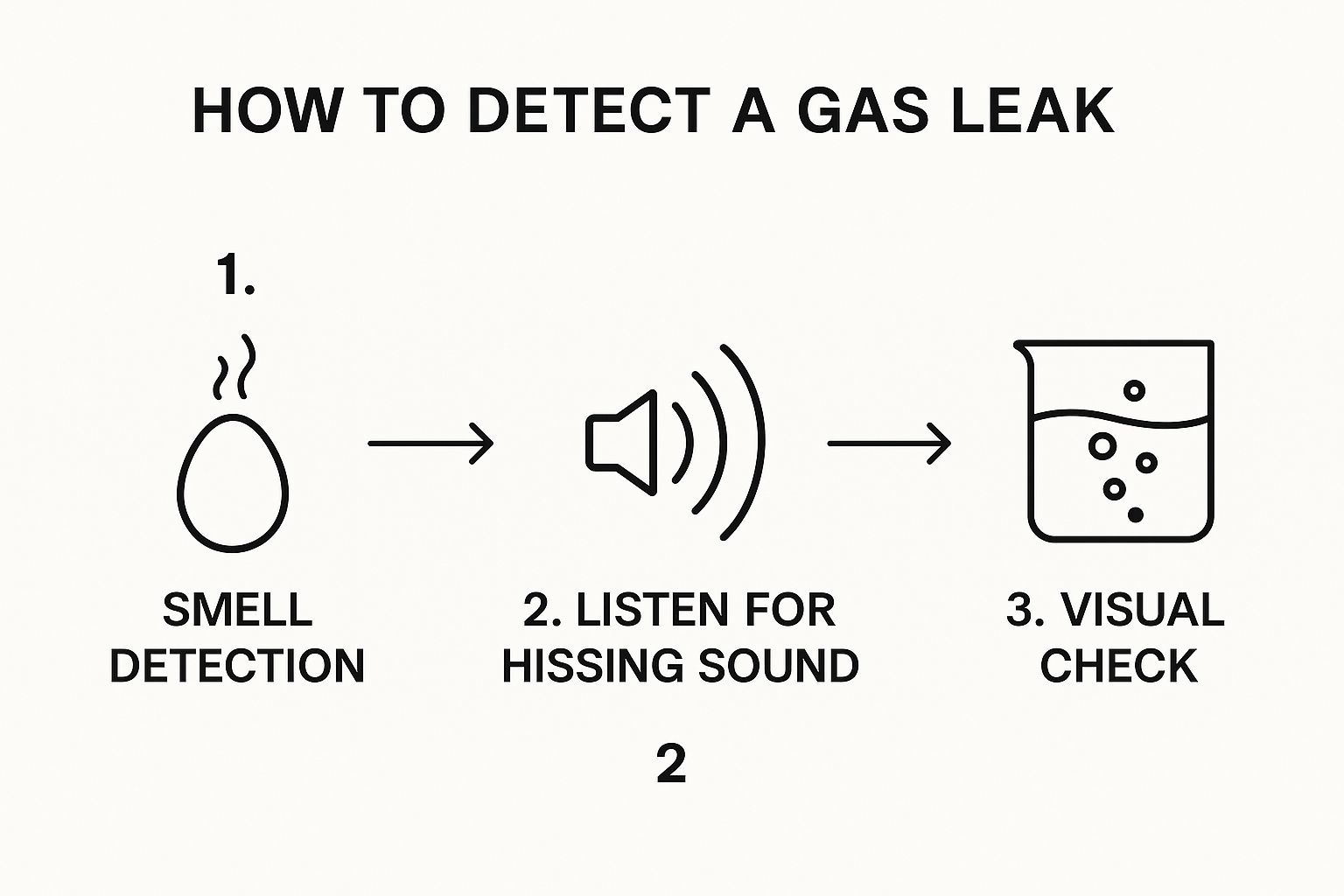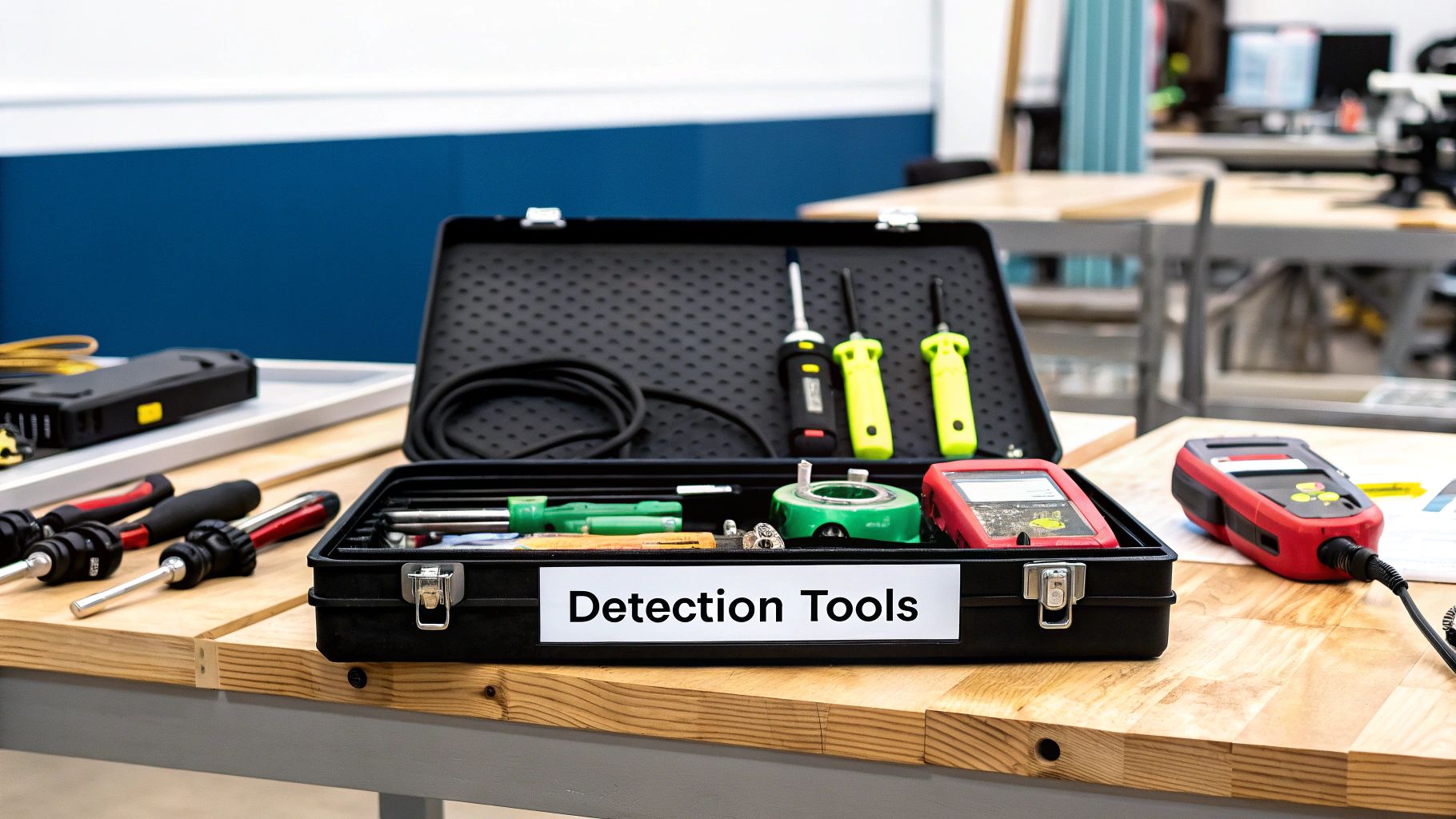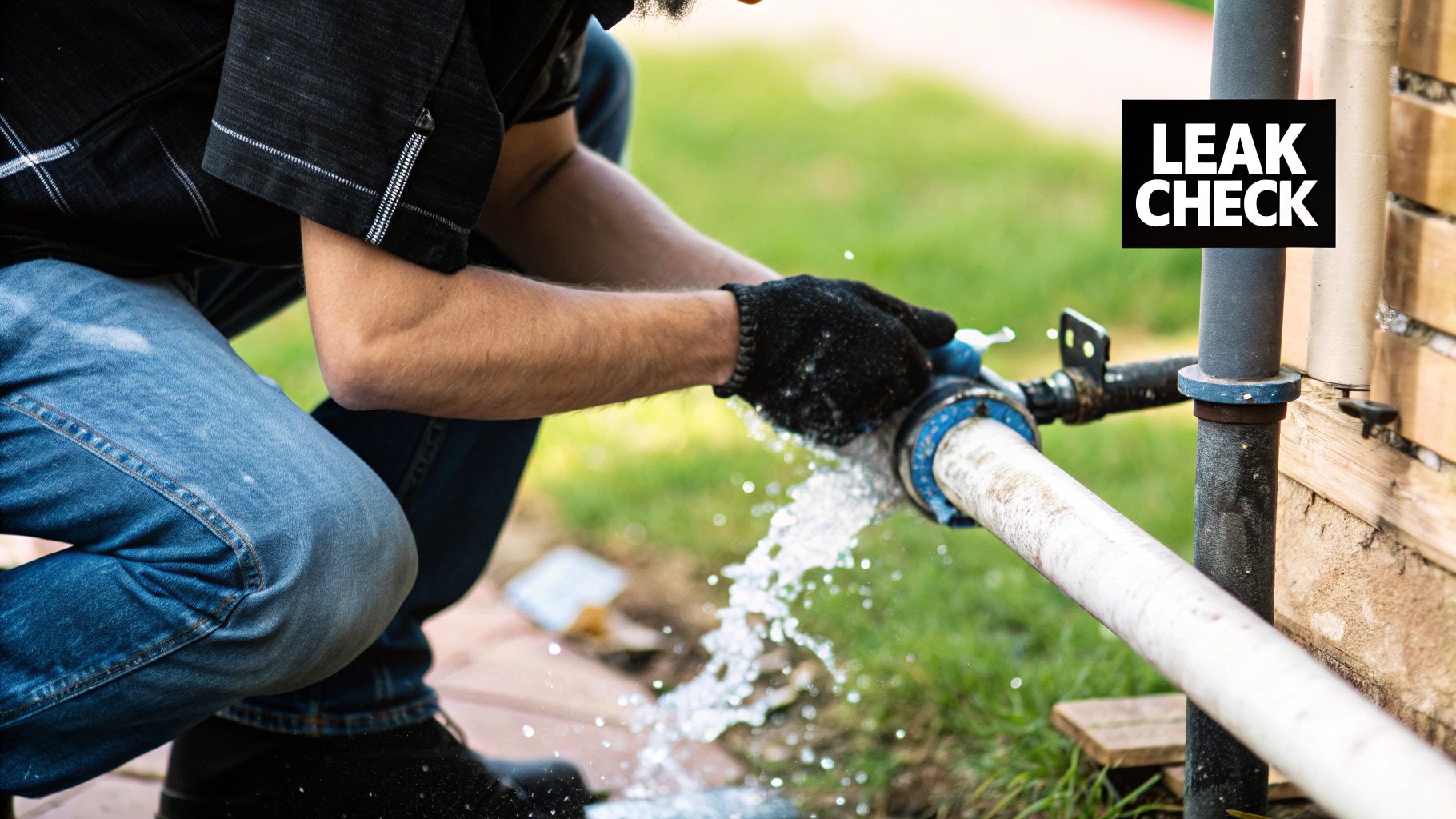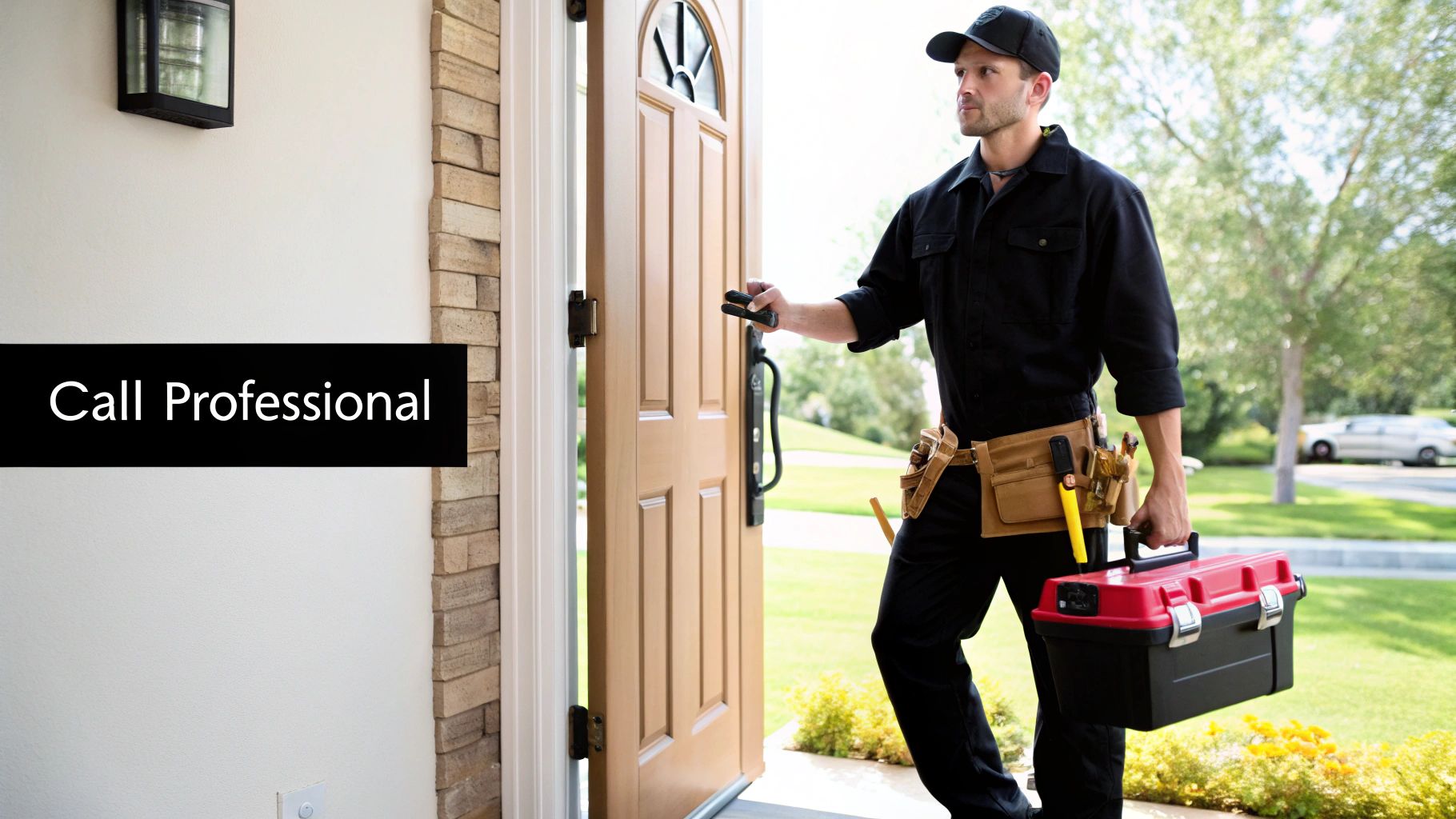How to Detect Gas Leaks A Homeowner's Guide
- Luke Yeates
- Sep 17
- 14 min read
The first sign of a gas leak usually comes down to your senses. You might hear a strange hissing sound near your gas appliances or pipes. You could even see something unusual, like dust blowing from a fitting or plants inexplicably dying near a gas line.
But the most obvious giveaway? The smell. Natural gas is actually odourless, so gas companies add a chemical called mercaptan to give it that distinct "rotten egg" smell. If you catch even a faint whiff of this, it's a serious red flag and your cue to act immediately.
Your Immediate Response to a Suspected Gas Leak
The second you think you have a gas leak, your one and only priority is safety. Forget trying to find the source or figuring out what's wrong—that comes later. Your job is to get everyone out safely and quickly.
Let's say you're making tea in your Eastbourne home and you notice that sulphurous smell. Your instinct might be to start sniffing around the boiler or cooker, but that's the wrong move. The first thing you must do is ensure everyone in the house is aware and ready to leave.
This image sums up the key sensory checks you can use to spot a potential leak.

It’s a simple reminder that your senses—smell, hearing, and sight—are your most reliable first alert system.
Gas Leak Emergency Dos and Don'ts
When you suspect a gas leak, knowing what not to do is just as important as knowing what to do. A single spark is all it takes to ignite the gas, so avoiding anything that could create one is absolutely critical. This table breaks down the essentials.
What to Do Immediately | What You Must Avoid |
|---|---|
Extinguish any naked flames like candles or fireplaces. | Do not turn any light switches on or off. |
Open all doors and windows to ventilate the property. | Don't use your mobile phone or any landline inside. |
Turn off the gas supply at the meter if you know how. | Avoid unplugging or plugging in any electrical appliances. |
Evacuate everyone (including pets) from the building now. | Never assume someone else has already reported the leak. |
Call the National Gas Emergency Service once safely outside. | Don't re-enter the property until a certified engineer says it's safe. |
This isn't a situation for hesitation. Follow these guidelines to the letter to keep everyone safe until help arrives.
Making the Right Calls from a Safe Distance
Once you and your family are safely outside and a good distance away from the property—think across the road or several houses down—it’s time to call for help. Don't even think about making these calls from inside the building.
Your first and most important call is to the National Gas Emergency Service on their free, 24/7 helpline: 0800 111 999. They will send out an engineer right away to locate the source of the leak, make the area safe, and shut off the gas supply if needed. Their job is to handle the emergency.
After they've given the all-clear, you’ll need a Gas Safe registered engineer to carry out the necessary repairs. For homeowners here in Eastbourne, that's where a trusted local team like us at Harrlie Plumbing and Heating comes in. Our engineers can then properly diagnose the fault, whether it's with an appliance or the pipework itself, and get everything back in safe working order.
It’s also worth noting the difference between a gas leak and a carbon monoxide issue. They're both serious dangers, but they're not the same and require different actions. We've put together a guide on what to do if your carbon monoxide alarm goes off, and understanding both is vital for home safety.
Recognising the Hidden Signs of a Gas Leak
While the strong, sulphurous smell of rotten eggs is the classic sign of a gas leak, it’s not the only one. Sometimes, a leak is a slow, chronic issue that doesn't announce itself so dramatically. These subtle signs are often easier to miss, but knowing how to spot them is just as vital for your safety.
These low-level leaks can release small amounts of gas into your home over a long period, leading to symptoms you might easily blame on something else. It’s about listening to your body and paying attention to your home's environment.

Unexplained Physical Symptoms
Prolonged exposure to low levels of natural gas can starve your body of oxygen, leading to a range of physical symptoms that can seem completely unrelated. If you or your family members are experiencing persistent health issues without a clear cause, it's worth considering your gas appliances as a potential source.
Here are some of the most common physical indicators:
Persistent Headaches: Not just a one-off, but recurring headaches that seem to improve when you leave the house.
Dizziness and Nausea: A constant feeling of light-headedness, being off-balance, or feeling sick to your stomach.
Unusual Fatigue: Feeling drained and exhausted even after a full night's sleep.
Breathing Difficulties: Experiencing shortness of breath or irritation in your throat.
We once had a call from a family in the Old Town area of Eastbourne who had been feeling unwell for weeks. They were dealing with constant headaches and tiredness and had been back and forth to the GP with no answers. During an annual boiler check, our Harrlie Plumbing and Heating engineer discovered a very small, slow leak from a corroded fitting. Once repaired, their symptoms cleared up within days. It’s a powerful reminder that your body often knows when something is wrong.
Visual Clues Around Your Home
Beyond how you feel, your home itself can provide visual warnings that something isn't right with your gas supply. These clues often appear around the appliances themselves, indicating incomplete combustion or escaping gas.
Keep an eye out for these environmental red flags:
A Lazy, Yellow Flame: The flame on your gas hob or fire should be crisp and blue. If you see a weak, yellow, or orange flame, it means the gas isn't burning correctly. This can be a sign of a leak or a serious ventilation problem that could produce carbon monoxide.
Soot Marks: Look for black, sooty stains on or around your gas appliances. This is another sign of incomplete combustion and is a serious warning that your appliance needs an immediate professional inspection.
Condensation on Windows: While condensation can have many causes, an unusual increase on the windows in the room where a gas appliance is located can sometimes point to a ventilation issue linked to the appliance.
A healthy gas flame is a sign of a healthy appliance. A crisp, blue flame indicates efficient and complete combustion. Any other colour—especially yellow or orange—is your cue to turn off the appliance and call a Gas Safe registered engineer immediately.
Telltale Signs in Your Garden
Gas leaks don't just happen inside. The pipes that supply your home run underground, and a leak can occur anywhere along that line. The signs here are often environmental, affecting the plant life directly above the leak.
If you're an avid Eastbourne gardener, you might be the first to spot an outdoor leak. Look for unexplained patches of dead or dying vegetation in your lawn or garden beds, especially if the area is near where you know your gas line runs. Escaping gas displaces oxygen in the soil, effectively suffocating the plant roots from below.
This can appear as a distinct patch of brown, dead grass or wilting plants in an otherwise healthy garden. If you notice this and there’s no other obvious cause, it's a clear signal to get it investigated by the National Gas Emergency Service.
Simple DIY Checks You Can Safely Perform
So, you’ve checked for the big, obvious signs of a major leak and come up empty, but you still have a nagging feeling something isn’t quite right. Is there anything else you can do yourself before calling in a professional?
While almost every part of your gas system is strictly off-limits to anyone but a Gas Safe registered engineer, there is one classic, reliable test you can safely carry out on accessible pipe fittings. It’s called the soapy water test.
This is a simple but effective way to pinpoint a suspected small leak at a specific joint. It's a technique we engineers at Harrlie Plumbing and Heating sometimes use ourselves for a quick visual confirmation on external connections. It's perfectly safe for a cautious homeowner to try, as long as you follow the safety rules to the letter.
The idea is simple: escaping gas will create bubbles in a soapy film. This test is only for visible, easy-to-reach connections, like the flexible hose connecting to your gas hob.
Preparing and Applying the Soap Solution
First things first, you need to mix your detection solution. Don't worry, it couldn't be easier.
Just combine a bit of washing-up liquid with water in a bowl or a spray bottle. You want a solution that’s sudsy but not so foamy that it’s all bubbles to begin with. Think of the consistency of the bubble mixture you’d buy for kids. A good ratio is roughly one part soap to five parts water.
Once your mixture is ready:
Make absolutely sure the gas appliance you're checking is turned off.
Using a small paintbrush, sponge, or the spray bottle, apply a generous layer of the soapy water directly onto the fitting or joint you think might be leaking.
Coat the entire area, making sure you cover all the threads and connection points completely.
The trick is to apply the liquid gently. You don’t want to create bubbles yourself; you’re looking to see if escaping gas will do the job for you.
Crucial Safety Note: This test is only for external, visible pipework you can get to easily without any tools. Never, ever try to test fittings on your gas meter, inside your boiler's casing, or on any pipes hidden in walls or under floorboards. Those areas are strictly for professionals.
This image shows exactly what you’re looking for – bubbles forming right at a connection point.

If you see new bubbles forming, whether they're big or small, that's your visual proof. You've found a leak.
Knowing When to Stop and Call an Expert
Reading the results of the soapy water test is dead simple. If you see bubbles forming, growing, or appearing in a steady stream, you’ve found a gas leak. There's no grey area here.
The moment you see those bubbles, your DIY work is done. Do not be tempted to grab a spanner and tighten the fitting or slap on some sealant. Messing with gas fittings without the proper training and equipment can quickly turn a tiny leak into a massive problem.
Your very next step is to ventilate the room well and immediately call a Gas Safe registered engineer.
For anyone in Eastbourne and the surrounding areas, this is where a call to Harrlie Plumbing and Heating gets you a fast, safe solution. Our certified engineers have the expertise to properly diagnose why it’s leaking and carry out the correct repair, ensuring the connection is secure and your home is safe again.
Think of the soapy water test not as a fix, but as a safe way to gather information before handing the problem over to the people who know exactly what to do.
Inside a Professional Gas Leak Detection Service
When you think you might have a gas leak, that soapy water trick is a decent place to start, but it's really just that—a starting point. For real peace of mind, you need a systematic, professional inspection from a Gas Safe registered engineer. Ever wondered what we actually do when we get a call-out for a suspected gas leak in Eastbourne? It’s a whole lot more than just a quick sniff around.
At Harrlie Plumbing and Heating, our entire process is built on precision and safety. We use specialised equipment that can pick up on problems your senses would never detect. From the moment we walk in, we’re carrying out a methodical safety assessment, getting the lay of the land and understanding your gas system before we even think about detailed testing.
This isn't about rushing. It's about being thorough and leaving no stone unturned. We're not just looking for an obvious hiss; we’re hunting for the faintest trace of gas that could point to a hidden danger.
The Power of Electronic Gas Analysers
One of the first bits of kit we’ll often pull out is an Electronic Gas Analyser (EGA), sometimes called a gas "sniffer." This handheld device is incredibly sensitive, able to detect tiny concentrations of gas in the air—we're talking parts per million that your nose would completely miss.
An EGA lets us trace the source of a leak with pinpoint accuracy. Imagine we're at a property in the Meads area of Eastbourne with a suspected leak around the boiler. We can run the analyser’s probe along every single pipe, joint, and seal. The device gives off an audible alarm that gets louder and faster the closer it gets to the source, guiding us straight to the problem without any guesswork.
Confirming System Integrity with a Manometer
Once we’ve used the EGA to investigate specific spots, the next logical step is to check the integrity of the whole system. For this, we bring out a manometer, a tool that measures gas pressure with extreme precision. The procedure is known as a tightness or pressure test.
To do this, we safely shut off your gas supply and connect the manometer to a test point, which is usually found near your gas meter. We then pressurise the pipework and let it sit for a specific amount of time.
If the pressure holds steady: Fantastic news. It confirms your entire network of pipes is sealed tight and leak-free.
If the pressure drops: Even the slightest drop means gas is escaping somewhere. This confirms a leak exists, even if its exact location isn't immediately obvious.
This test is the definitive way to know for sure if your pipework is sound. It’s a vital part of any proper gas safety check, and understanding how long a gas safety check takes can give you more insight into the complete process.
A professional gas leak detection service isn't just about finding a leak; it's about proving the absence of one. The manometer pressure test provides a conclusive result on the safety of your entire gas installation, offering genuine reassurance.
A Typical Visit from Harrlie Plumbing and Heating
So, what does all this look like in practice? When we visit your home, we follow a clear, methodical path designed for maximum safety and accuracy.
We always start with a chat to understand your concerns before we begin any visual inspections or start using our equipment. We'll check your appliances, pipework, and ventilation, combining years of experience with the hard data from our tools to build a complete picture of what's going on.
If we do find a leak, we’ll explain the problem clearly, show you the evidence from our equipment, and talk you through the safest and most effective way to repair it. Our goal isn’t just to fix the immediate issue but to make sure your system is secure for the long term, giving you total confidence in the safety of your home.
Preventing Gas Leaks with Proactive Maintenance
Knowing how to spot a gas leak is one thing, but preventing one from ever happening? That’s the real goal. It’s about shifting from a reactive panic to a proactive mindset. Think of your gas appliances and pipework less like 'fit and forget' bits of kit and more like the critical systems they are—they need regular, professional TLC to stay safe.
This isn't just about dodging emergencies; it's about keeping things efficient and giving you peace of mind. An annual service isn't a mere suggestion—it’s probably the most important safety check you can book for your home.

Why an Annual Boiler Service is Non-Negotiable
You can think of an annual boiler service as an MOT for your central heating. It's a comprehensive health check from a Gas Safe registered engineer, designed specifically to catch small issues before they become dangerous failures. During a service, an engineer does far more than just wipe things down; they run a series of critical safety and performance tests.
For homeowners in Eastbourne, a visit from one of our Harrlie Plumbing and Heating engineers means a meticulous inspection. We’re trained to spot the subtle signs of wear and tear that an untrained eye would easily miss.
Here’s a glimpse of what we look for:
Pipework Corrosion: We carefully check all visible gas pipes for any hint of rust or decay. Corrosion weakens the pipe and can eventually lead to leaks.
Seal Integrity: Over time, the seals and gaskets inside your boiler can dry out, shrink, and perish. We make sure they’re still pliable and creating a perfect, gas-tight connection.
Safety Device Function: Modern boilers come packed with safety mechanisms. We test these to ensure they're working correctly and will shut the appliance down instantly if a fault is found.
This preventative approach is the absolute cornerstone of gas safety. For a deeper look at what a full service involves, our guide on how to service a boiler for Eastbourne homeowners breaks it all down.
Simple Homeowner Habits for Gas Safety
While the technical checks are strictly for the pros, there are a few simple habits you can adopt to help keep your gas appliances safe. It mostly boils down to making sure your appliances can "breathe."
Proper ventilation is vital for safe gas combustion. Never, ever block or cover air vents, grilles, or flues that supply air to your appliances or get rid of waste gases. We often see vents in older Eastbourne properties that have been accidentally painted over or covered during redecorating—a huge safety risk.
An appliance that's starved of air can't burn fuel correctly, which dramatically increases the risk of it producing deadly carbon monoxide. Always keep your air vents clear and unobstructed.
The Landlord’s Legal Responsibility: A CP12 Certificate
If you're a landlord in Eastbourne or anywhere in the UK, proactive gas safety isn't just good practice—it's the law. Landlords are legally required to have a Gas Safe registered engineer perform a gas safety check on all pipework and appliances in their rental properties every 12 months.
Once the check is done, the engineer issues a Gas Safety Certificate, often called a CP12. This is the official document confirming that all gas installations are safe to use. A copy must be given to your tenants, proving the property meets strict safety standards.
At Harrlie Plumbing and Heating, we work with many local landlords to help them meet their legal duties. We provide reliable annual checks and CP12 certificates to keep their properties safe and their tenants protected.
Got Questions About Gas Leaks? We've Got Answers
Even when you know the basics of spotting a gas leak, it's normal to have a few questions rattling around. Over the years, our team at Harrlie Plumbing and Heating has answered hundreds of calls from concerned Eastbourne residents, and we've noticed the same worries tend to crop up.
Let's clear the air and tackle some of the most common questions we hear. Getting straight answers is the first step to feeling safe in your own home, because when it comes to gas, misinformation can be just as risky as ignoring the problem altogether.
Can My Smart Meter Detect a Gas Leak?
We get asked this all the time, and the answer is a simple but very firm no. A smart meter is a fantastic bit of kit for keeping an eye on your gas usage and managing your bills, but that's where its job ends. It's designed to measure the volume of gas flowing through it, not to sniff the air for unburnt gas.
Think of it this way: your water meter tells you how much water you've used, but it has no idea if a pipe is quietly leaking under your floorboards. If you have a serious gas leak, your smart meter will just log it as unusually high consumption. It's a tracking tool, not a safety alarm.
Gas Detectors vs Carbon Monoxide Alarms: What's the Difference?
It’s incredibly easy to mix these two life-saving devices up, but they perform two completely different jobs. Getting them confused can leave a dangerous blind spot in your home's safety net.
Here’s the simplest way to remember it:
A Natural Gas Detector sniffs out raw, unburnt natural gas in the air—the kind that escapes from a leaky pipe or a dodgy appliance connection. Its purpose is to warn you about a fire or explosion risk.
A Carbon Monoxide (CO) Alarm detects carbon monoxide, a toxic gas that’s a byproduct of incomplete combustion. This happens when a fuel-burning appliance, like your boiler or gas fire, isn't working right and can't vent properly. Its job is to warn you of a poisoning risk.
You absolutely need both. One protects you from the fuel itself, while the other protects you from the dangerous fumes that faulty appliances can create. Having only one is like locking your front door but leaving the back door wide open.
How Much Will It Cost to Fix a Gas Leak?
This is the big question on everyone's mind, and the honest-to-goodness answer is: it really depends on the problem. A straightforward fix, like tightening a loose fitting on an easy-to-reach cooker pipe, will be a relatively low-cost call-out.
On the other hand, a more complicated job—like tracking down and repairing a leak in pipework hidden under your floorboards—is naturally going to take more time and labour. The UK's focus on pipeline safety is immense, with the leak detection market being a multi-billion-pound industry, which just shows how seriously this is taken.
The only way to get a real figure is to have a Gas Safe registered engineer carry out a proper diagnosis. At Harrlie Plumbing and Heating, our first move is always to conduct a thorough investigation using specialised equipment to pinpoint the exact source of the leak. Once we know what we're dealing with, we can give you a clear, no-obligation quote for the repair, so you understand all the costs involved before we even think about starting.
If you even slightly suspect a gas leak or just want the peace of mind that comes with a professional safety check, don't wait. Contact Harrlie Plumbing and Heating today for a rapid, reliable, and Gas Safe registered service in Eastbourne. Visit us online to book an appointment or call for an emergency response.

Comments